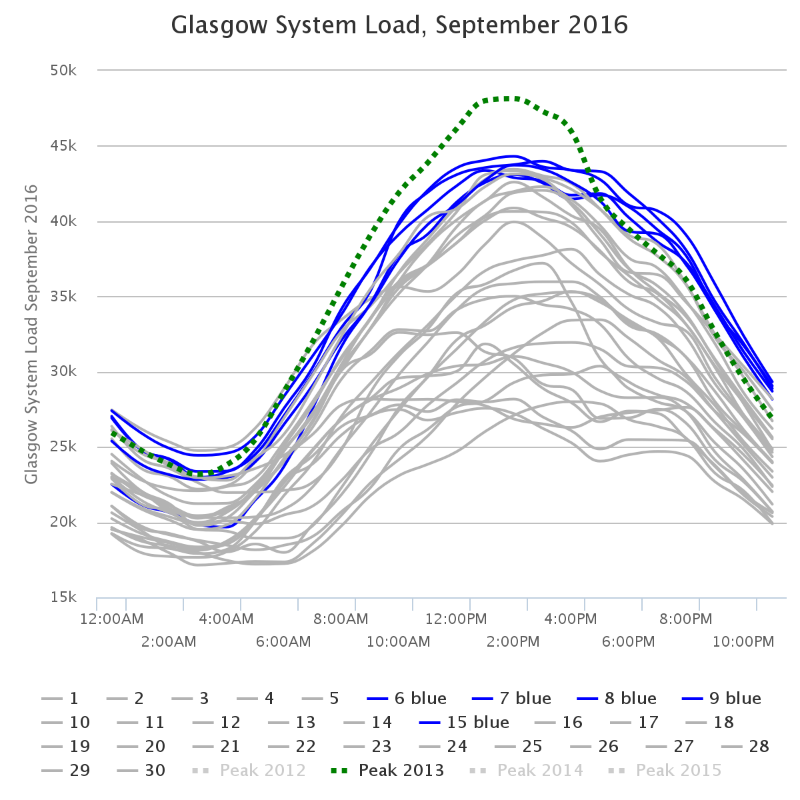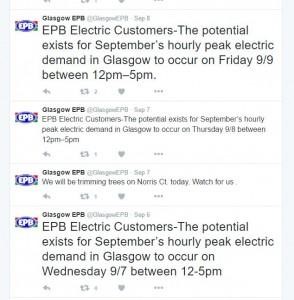This blog was written by John D. Wilson, former Deputy Director for Regulatory Policy at the Southern Alliance for Clean Energy.
Guest Blog | November 11, 2016 | Energy Policy Glasgow Electric Power Board (EPB), one of the Tennessee Valley Authority‘s member utilities, has established a reputation of being a thoughtful and forward-looking company. For nearly two decades, Glasgow EPB has been a leader in the deployment of smart grid technologies and practices. For example, in 2007, Glasgow EPB began installing fiber-based broadband to all its customers. In 2011, Glasgow EPB initiated a study of smart appliances. The list could go on.
Glasgow Electric Power Board (EPB), one of the Tennessee Valley Authority‘s member utilities, has established a reputation of being a thoughtful and forward-looking company. For nearly two decades, Glasgow EPB has been a leader in the deployment of smart grid technologies and practices. For example, in 2007, Glasgow EPB began installing fiber-based broadband to all its customers. In 2011, Glasgow EPB initiated a study of smart appliances. The list could go on.
However, Glasgow EPB’s risk-taking approach misfired this year. In January 2016, Glasgow EPB switched from traditional electric rates (cents per kWh) to a new demand charge rate for all residential and small commercial customers. As illustrated at right, this rate change means a customer can cut energy use dramatically, but still pay a higher bill.
According to Glasgow City Council Member Wendell Honeycutt, the EPB is the first utility in the country to make the rate structure mandatory for all customers. In May 2016, he brought concerns from the public before the Glasgow County Council, as reported in Council minutes:
During a lengthy discussion, Council Member Honeycutt commented that people on fixed incomes or with medical problems cannot always turn off their heat or air conditioning for several hours during the coincident demand peak time, which is the one hour during each month in which demand is highest for electrical usage.
The Council asked Glasgow EPB to consider making changes to address the concerns. By late August, Glasgow EPB had made a time-of-use rate available and also indicated that a new, simple rate would be made available by early October. Why did the EPB make changes? What does that say about the challenges of aligning the cost of power with customer rates and bills?
Pros and cons of the Glasgow EPB demand charge

Last November, Glasgow EPB Superintendent Billy Ray initially explained the EPB demand charge as a matter of correcting the subsidies.
“Under the old rates, if a customer used very few kWh and had a significant contribution to peak kW demand, then the customer’s bill was not large enough to even pay TVA for the wholesale energy cost, leaving nothing to compensate EPB for the value of being connected to the grid,” Ray told the Daily Times. “Those customers are going to be paying more because their costs were not formerly being covered. Those folks were being subsidized by other customers that were paying more than their actual fair share. There is really no way to sugar coat that. The new rate makes sure that all pay their fair share and that no one pays more than their fair share.”
More recently, as illustrated below, Mr. Ray has explained that the new rate structure actually helps Glasgow EPB customers save money. So from EPB’s point of view, the new rates are about reducing subsidies and helping customers save money.
However, as reported by E&E, reducing subsidies and helping customers save money is causing fear and hardship for some residents.
In July alone, there were more than 50 hours’ worth of peak alerts. The warnings led senior citizens to spend afternoons roaming the aisles of Wal-Mart or sitting around the senior center to avoid rate shock.
Shops in town stayed dark during business hours to avoid rate shock. And some residents said they had to drive home from work in the middle of the day to make sure appliances were off.
For some, like the E-Z Tan Tanning salon, which occupies part a strip mall just off Glasgow’s main drag, owner Roger Walker has little control over when customers will come in.
Walker’s salon has 50 tons of air conditioning capacity to offset the heat from 37 tanning beds. He tries to turn off lights in hallways during the day and adjusts the temperature when business is slow. But he knows he’s probably losing money on anyone who comes in to tan during the hour of the month when usage on Glasgow’s electric system peaks.
One customer reported that even though the family electric bill was lower, the “mystery hour” demand charge had definitely worsened their quality of life. And the thousands of frustrated or angry customers had to get the attention of Kentucky Attorney General Andy Beshear. Beshear’s strongly worded letter appears to have prodded Glasgow EPB to respond to the concerns first aired at the May City Council meeting.
Learning from Glasgow EPB’s experience

In yesterday’s blog, I wrote about how the energy front group Consumer Energy Alliance is scapegoating solar customers. The Glasgow EPB story helps illustrate one of the mistakes CEA made in its report. CEA described traditional electric rates (cents per kWh) as mainly a result of now-outdated metering technology. CEA’s report implies that electric rates should be set, in part, based on peak energy use.
As the Glasgow EPB experience illustrates, customers really don’t know how to control peak energy use. It’s not effective to send 50 peak alerts in a month to send customers scrambling to cut energy use, when in fact the demand charge is set based on a single hour that isn’t known until well after the fact.
A better approach is to set a more predictable time of use rate, such as the one recommended by Attorney General Beshear’s office. The attorney general recommended that the EPB adopt critical peak pricing (CPP). The CPP recommendation is intended to alleviate the backward-looking rate with high kW charges and many false alarms. Instead, customers would have a standard rate for most hours, and an increased CPP rate for certain critical hours. This CPP rate would collect the demand charge that has angered many EPB customers, but spread it out over multiple hours, thus “balancing the interests of all residential and commercial customers.” The attorney general’s recommendation is similar to the direction encouraged in the recent Xcel Energy rate settlement.
SACE is involved in rate design discussions with utilities across the Southeast, and the Glasgow EPB’s experience should be a caution to utilities that are unilaterally imposing new rate structures without including customers and other stakeholders in the conversation. If you are interested in learning more about this topic, a good starting point for learning about the issues of rate design was published by the Regulatory Assistance Project in 2015.